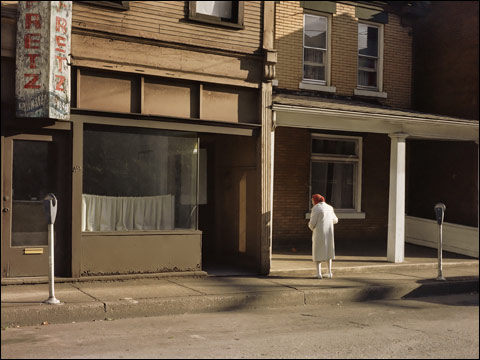
MORNING IN MONESSEN, PENNSYLVANIA (1983) The Currier exhibit strips the context of social critique from Liebling’s Hopper-esque photo. |
“Imprints: Photographs by Mark Ruwedel” | Peabody Essex Museum, East India Square, Salem | through January 1 “Jerome Liebling: Capturing the Human Spirit” | Currier Museum of Art, 150 Ash St, Manchester, New Hampshire | through September 19 |
The tracks run side by side across cracked, dried mud. They look as if they could have been made after last night's rain, by some giant beasts heading off toward the scrub and the rocky hills in the distance. But this black-and-white photo by Mark Ruwedel is deceptive. In fact, these tracks are millennia-old brontosaur footprints turned to stone, a frozen record of a pair or group of beasts, perhaps following the shore of a large shallow lake, now long since vanished, near what today is the Purgatoire River in Colorado.
For 15 years, Ruwedel has wandered between his home in Long Beach, California, and Texas, photographing dinosaur tracks and ancient human footpaths winding across arid desert moonscapes. "Imprints," organized at Salem's Peabody Essex Museum by curator Phillip Prodger, collects 41 of his large-format photos for a rumination on time.
Chocolate Mountains, A Ceremonial Trail on an Ancient Terrace (2001) records shimmering footsteps heading toward jagged peaks. Ruwedel is a master of using fine black-and-white tones to bring out textures. (He's not as sharp with color.) A 1996 photo from that same California region reveals a faint trail, seemingly pressed smooth by use, through a field of gravel and boulders. Some photos show rocks arranged in wiggling lines to resemble snakes at Sears Point near the Gila River in Arizona. Ancient sauropod tracks look as if they'd been pressed into the stone floor of a notch at Moccasin Mountain in Utah by the weight of the massive, long-necked, four-legged dinosaurs.
One 1996 photo shows a mysterious stairway carved into a smooth cliff and leading up to a scrubby desert plain at Chaco Canyon in New Mexico. It's an uncanny sight, pulsing with questions about who built it and when and why? It's called the Jackson Stairway, after William Henry Jackson, who photographed the area in the late 1800s as part of the US Geological Survey. But it's believed to have been carved into the rock between 850 and 1250 AD by the Chacoan people, who cleared remarkably wide straight roads across the desert and cut stairways up mesas that got in their way.
In part, Ruwedel is carving out a Venn-diagram intersection between 1970s Land Art and 19th-century US Geological Survey photos that mapped the West, opening it up for trains and white settlers and displacing Native Americans. Railroad cuts through mountains reminded him of Earthworks like Michael Heizer's Double Negative, a trench carved across a Nevada canyon in the 1960s. And that got him thinking about how the traces people leave on the land reveal their thinking, their values.